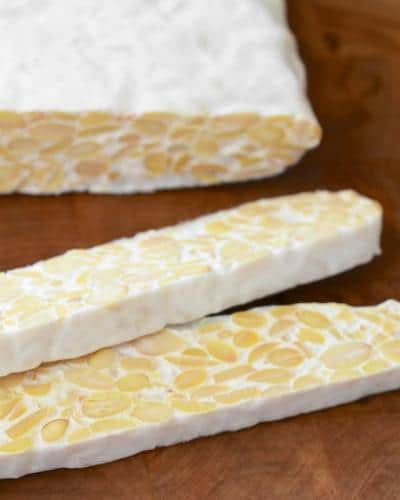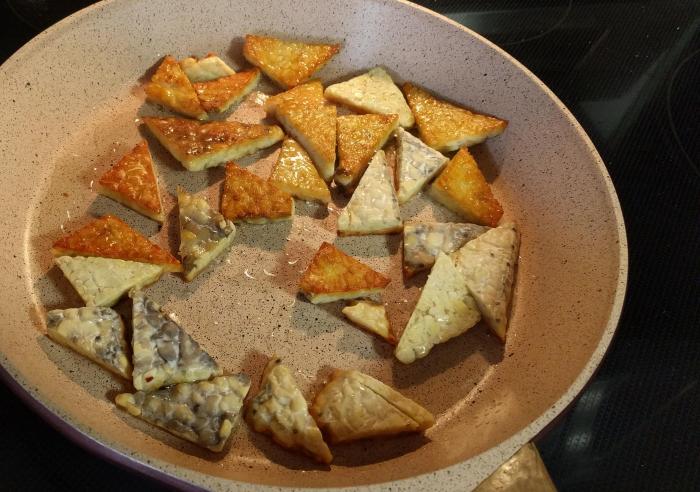How To Tell If Tempeh Has Gone Bad (Quick Tips)
Tempeh is one of the lesser-known meat substitutes, although we can’t figure out why.
It’s more dense and firm than tofu but is gluten-free unlike seitan. And like both tofu and seitan, it takes on the flavor of whatever you cook it in.
In this #VeganQuickTip, we will cover what Tempeh is and how you can know if it has gone bad.
If you enjoy this article, you will also love A Field Guide to Tofu, Tempeh, and Seitan.
What Is Tempeh And How Is It Made?
Tempeh, like tofu, is made from soybeans. The primary difference is that the soybeans in tempeh are fermented, making it a great source of probiotics (some other common fermented foods are kombucha, kimchi, and miso). This is part of what makes the product a little unusual but also very healthy.
It is possible to make your own tempeh, but it’s absolutely not necessary. While it’s less common than tofu, you can probably still find it at your local health food store for a reasonable price.
Tempeh is made by combining soybeans with a “tempeh starter.” The starter is a culture called “Rhizopus” mold spores. It sounds gross, but it’s perfectly safe. This culture binds with the soybeans to create the loaf of tempeh. You can read a more detailed description here.
The Aging Process: From Creation to Spoiled
Obviously with any fermented food it has to age for a period of time. But how can you tell if your tempeh is perfectly fine or has gone bad?
Tempeh is typically white when it’s freshest. It should have a smell that many people compare to yeast or mushrooms. It should also be firm.
After a few days in the refrigerator (tempeh MUST be refrigerated), it may take on a greyish tint or develop some grey spots. Don’t panic! Since tempeh contains live cultures, they are continuing to live and change even after the tempeh has been made.
Bottom line: if it smells okay, is still firm, and is white/grey, your tempeh is most likely a-okay.

Here is a picture of Tempeh from TheKitchn's How To Make Tempeh article. This is an example of perfectly fresh Tempeh.
Black/Grey spots on tempeh?
If you spot black spots (Well, more realistically speaking, the spots will be a dark gray) on your tempeh, don't panic. That is a completely normal. Those black spots are spores that indicate the fermentation process is complete.
Refer to the image below and see if your dark spots are similar.


Need another image? Here's a picture from Doug of KeepItVegan during his first experiments with tempeh. You can see some of the unflipped tempeh having that dark gray color.
Your Tempeh Is No Good If...
My number one tip for figuring this out is to smell your tempeh. A strong, sour odor is the best indication that your tempeh has bit the dust.
The color of Tempeh can be a bit of a tricky indicator since dark-gray spots are perfectly normal. (As mentioned in the previous section.)
If you see that the beans in your tempeh are no longer white (and are very dark), then that is another indicator of spoiled tempeh. (Disregard this tip if you are using black bean tempeh.)
Another red flag is if your tempeh has slime on or around it. Store-bought tempeh may have some liquid in the packaging, but it’s usually very watery (if not it’s not actually just water). It’s also a pretty small amount.
Lastly, you should take note of the texture. If it is very mushy it is no good. Proper tempeh should be anywhere firm to slightly firm.
Bottom line: if you open your tempeh one day and it smells disgusting, has dark beans, and is covered in slimey fluid, it’s time to toss it.
Conclusion
If this article is your first introduction to tempeh, it may seem daunting. The good news is that tempeh is pretty cheap and easy to cook with, so you can try it out a few times with pretty low risk.
We recommend that if you’re buying tempeh for the first time to check the expiration date carefully and to use it within a day or two. That way you can get the hang of it and feel more confident next time. Pretty soon, you’ll be eating it all the time.
Disclaimer
Being that this article discusses the topic of "Is [food item] still safe to eat" it is always smart to provide a disclaimer. Here it is:
This article provides general information and discussions about health and related subjects. The information and other content provided in this article, or in any linked materials, are not intended and should not be construed as medical/nutritional advice, nor is the information a substitute for professional medical/nutritional expertise or treatment.
If you or any other person has a medical concern, you should consult with your health care provider or seek other professional medical treatment. Never disregard professional medical advice or delay in seeking it because of something that have read on this blog or in any linked materials. If you think you may have a medical emergency, call your doctor or emergency services immediately.
The opinions and views expressed on this article and website have no relation to those of any academic, hospital, health practice or other institution.
If this article saved your day,
it would mean a lot if you could share it on social media!

Leave a Comment
14 comments
The temphe I just took out of my dehydrator has a fuzzy looking gray mold on the top. It was in the dehydrator at a low setting for about 40 hours. It doesn’t smell bad, but, it’s never had gray fuzzy mold, just the white mold. It doesn’t smell bad. What do you think?
Thank you,
Gail
Hi Gail. That sounds like you put your tempe too long in the dehydrator – too hot. What temperature did you set? If you can tell more specific on your method, I might be able to answer with what happened with your tempe.
I’ve been eating tempeh for YEARS and will never consider making my own. I’m more of an, “ignore that man behind the curtain,” kind of person. Or to quote Paul Buchman, “Some people make apples; some people buy apples.” I’m happy to buy the apples. That said, for the first time EVER, I saw black spots around the edges of my most recent package. More like veins growing which freaked me out a bit. Thanks for this clarification. I’ll compare mine to the images you’ve shared (it’s very close) and give it the check for slime and ammonia smell. Since quarantine I’ve not been going to Whole Foods for my normal brand so there’s that. I’m not even 100% vegan but I’d be upset without at least one pack of tempeh in my fridge. At least I have some Smokey Strips as a fallback, lol.
I have tried to make my own tempeh starter, and after my tempeh was white I uncovered it and left it to dry. The common instruction is that it should have dark spots, and I know I also read that it stinks, so the incubator should be kept outside, in the garage etc. It has been 3 days now that my tempeh is grey, it is much darker but still not completely dry, and it still has a strong, unpleasant, sweetish smell. I kept it outside in the draft to dry, and it is around 20°C here, but now I am not so sure what to do. Should I wait longer, until it is completely hard, so that I can pulverize it as all the instructions say even if it smells, or should I discard it? Should dry tempeh, that is used as a starter, smell? Store-bought starter is very expensive here in Switzerland, and this tempeh process has now lasted 7 days, and is still not over. Should I have kept grey sporulating tempeh uncovered in the fridge? Then the whole fridge would smell, and noone mentioned anything about it anyway. I am rather exhausted, discouraged and totally disappointed by this experiment, and since I cannot afford the store-bought tempeh, this seems to be the end of this. Does anyone have a good advice for me? Thanks in advance, Aranyani
I think you missed one step at the very beginning, before you leave it to dry you need to give it about 24 more hours to turn a nice grey/black (no slime or anything, just a color change and maybe a bit more fuzz) which means it has spored. Once you achieve that then you leave it to dry and so on…
I really needed to read/see this as I’ve just made my first batch and one cake went a little grey and the dogs nearly had it for dinner. I don’t agree on saying tempeh is ‘pretty cheap’ at $7 a pop in the shops – hence my making it myself.
Oops! I should have read your article before I took my tempeh back to the store and returned it for a refund because it had some black/gray spots on it! Rookie mistake from a first time tempeh user!
Thanks for the pictures and the info! Just what I needed to check on my first use of tempeh.
Great site, thank you! I almost threw a package of tempeh out for all the wrong reasons
I was in the same boat! I’m glad you liked the article. 🙂
Thanks for the article! Can you also advise if is it ok our not, when the tempeh becomes slightly yellow after a few days in the fridge?
Thanks for this article, quite helpful 🙂 Mine had black spots, so now I know it’s OK.
Glad it helped you out, Petr! I was in the same boat as you but had to do a bunch of research since there was no helpful article available. Hope this saved you some time.